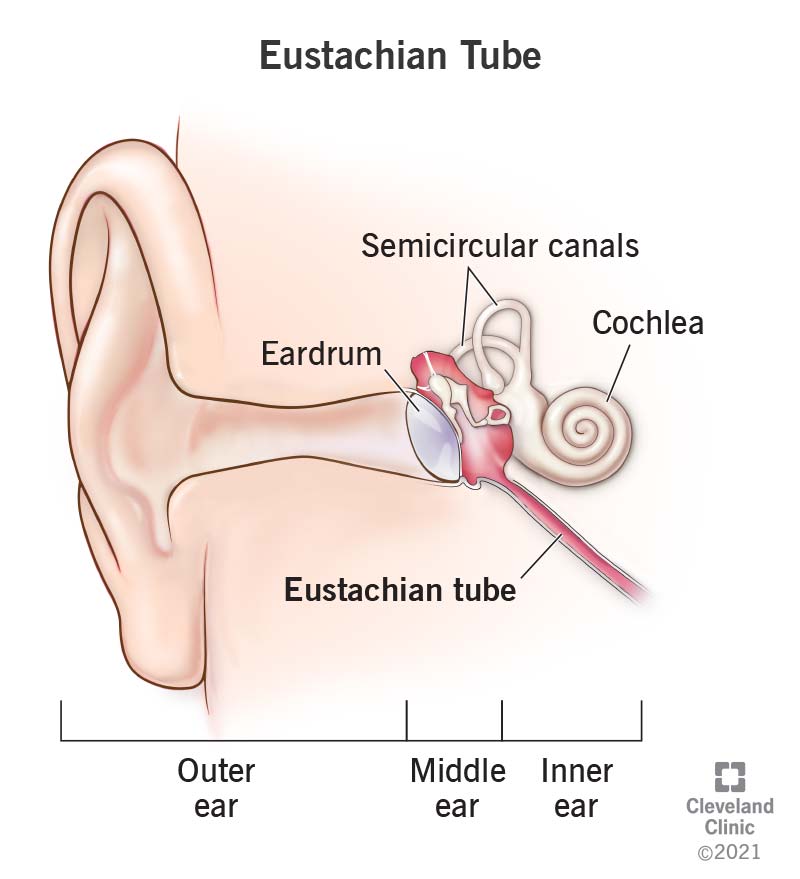Eustachian tubes connect the middle ears to the back of your throat. They help drain fluid and equalize the air pressure inside your ears. Sometimes, your eustachian tubes can become blocked due to colds, allergies or infections. Clogged eustachian tubes may resolve on their own or with the use of decongestants, antibiotics or other medications.

Eustachian (pronounced “you-stay-shee-un”) tubes run from the middle ears to the back of your nose and throat. They’re located on each side of your face. Most of the time, your eustachian tubes stay closed. But when you yawn, chew or swallow, they open. The eustachian tube is named after Bartolomeo Eustachi, the Italian physician who discovered that the tube connected the middle ear to the nose and throat.
Advertisement
Cleveland Clinic is a non-profit academic medical center. Advertising on our site helps support our mission. We do not endorse non-Cleveland Clinic products or services. Policy
Your eustachian tubes have three primary functions. They:
Proper eustachian tube function helps maintain overall ear health, including your sense of hearing.
If your ears “pop” when you yawn, you’re actually hearing the eustachian tubes open. They do this to equalize the pressure in your middle ear with the outside air pressure.
Advertisement
Your eustachian tubes extend from your middle ear to the upper part of your throat, just behind your nose.
Your eustachian tube is a hollow canal that runs about 36 millimeters (mm) in length. The first 12 mm, nearest to your middle ear, is made of bone. The remaining 24 mm, closest to your nose and throat, is made of elastic fibrocartilage (tough, flexible cartilage).
Advertisement
If your eustachian tubes don’t function properly, it can result in fluid buildup, ear pressure or ear pain. Eustachian tube dysfunction (ETD) may be associated with ear infections. The most common ETDs include:
This condition occurs when your eustachian tubes stay open. When this happens, sound may travel from your nasal cavity to your ears, causing you to hear your own breathing or your own voice too loudly. You might even hear your own blood pumping.
Caused by chronic nasal allergies, weight loss, GERD (chronic acid reflux) or neuromuscular diseases, patulous eustachian tube dysfunction is often resolved with nasal drops. Or your symptoms may improve if you drink more water or limit caffeine and decongestants. In severe cases, surgery may be necessary to correct the issue.
This condition occurs when your eustachian tubes don’t open properly. As a result, fluid may build up in your ears and you may experience pain or pressure. Many people with obstructive eustachian tube dysfunction experience muffled hearing as well.
Obstructive eustachian tube dysfunction can be caused by environmental allergies, acid reflux, sinusitis or abnormal tissue growth, such as ear tumors. You may be able to ease your symptoms by taking medication and avoiding triggers. Some people might need surgery, which may include balloon dilation of their eustachian tube, adenoid removal, placement of ear tubes or tissue mass removal. Appropriate treatment depends on the cause of the dysfunction.
This condition is similar to obstructive ETD — it occurs when your eustachian tubes don’t open properly. However, people with baro-challenge-induced ETD only develop symptoms when traveling by airplane, scuba diving, driving through the mountains or engaging in other activities that involve atmospheric pressure changes.
Like obstructive ETD, treatment for baro-challenge-induced ETD depends on the cause. However, research has indicated that balloon dilation of the eustachian tube is highly effective for military pilots and divers with the condition.
If you have eustachian tube dysfunction, you may develop a range of uncomfortable symptoms, including:
If you’re showing signs of eustachian tube dysfunction, your healthcare provider will examine your eardrum to see if it’s functioning properly. They may also run tests to measure the pressure inside of your ear.
In many cases, eustachian tube dysfunction goes away on its own. Conservative treatments, such as taking medication and avoiding triggers, are often helpful. Severe or chronic eustachian tube dysfunction may require surgery.
Keep in mind that even though antihistamines and decongestants may work for some people, they can actually make eustachian tube dysfunction worse in some cases. If you’ve had symptoms for longer than a week, call your healthcare provider. They can help you determine the appropriate course of action.
If you have minor symptoms of a clogged eustachian tube, you may be able to clear it with some simple exercises:
Use your finger to find a bony bump behind your ear lobe. Using firm, steady pressure, slide your finger down until you feel a groove between your ear lobe and jaw. Trace that groove all the way down your neck to your collarbone using the same firm pressure. Repeat this process three times on each side, three times a day.
Pinch your nostrils, close your mouth and push air out, like you’re blowing up a balloon. Don’t blow too forcefully, however, as you could rupture your eardrum. People with high blood pressure or those at risk for stroke or heart attack should not attempt the Valsalva maneuver.
A note from Cleveland Clinic
Your eustachian tubes help keep your middle ear healthy. Allergies, colds or infections can cause eustachian tube dysfunction, which can lead to pain, dizziness, hearing problems and other issues. Most of the time, eustachian tube dysfunction (ETD) goes away on its own. But if you have symptoms that last longer than two weeks, schedule a visit with your healthcare provider. They can determine the cause of the problem and design a personalized treatment plan.
Last reviewed on 11/15/2021.
Learn more about the Health Library and our editorial process.
Advertisement
Cleveland Clinic is a non-profit academic medical center. Advertising on our site helps support our mission. We do not endorse non-Cleveland Clinic products or services. Policy